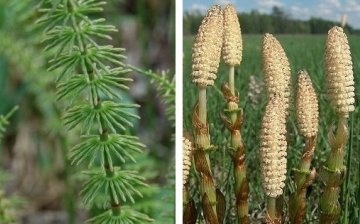Horsetail. Its scope
Horsetail is a spore-bearing perennial plant. Horsetail has a double stem: first it is spore-bearing, then vegetative. Unbranched spore-bearing stems grow up to 20-30 centimeters, appearing after snow melt, in very early spring.
After ripening, the spore-bearing stem dies off, being replaced by a green vegetative stem, knobby, tough, resembling in appearance a small herringbone 30-60 cm in height.
Horsetail spores mature in April-May.
Horsetail is widespread on the territory of Russia almost everywhere, with the exception of the Far North. Prefers wastelands, meadows, fields, lake and river shores.
The medicinal properties of the vegetative branching shoots of horsetail have been known for a long time.
Traditional medicine uses field horsetail for pulmonary tuberculosis, bone pain, kidney and cholelithiasis, atherosclerosis, eye diseases, cystitis, rheumatism, stomach and intestinal neoplasms, and for many types of bleeding as a hemostatic agent.
Horsetail has a hemostatic, diuretic, cardiotonic, anti-inflammatory, disinfectant, astringent, tonic, wound healing effect.
They practice the use of collecting herbs with horsetail for gout, hypertension and poorly healing wounds. Scientific and traditional medicine uses horsetail for inflammatory renal diseases, inflammation of the bladder, exudative pleurisy, edema of various origins.
Horsetail is also used externally, douching with leucorrhoea, in the treatment of fistulas, chronic ulcers. They wash their hair with seborrhea, make foot baths with sweating.



